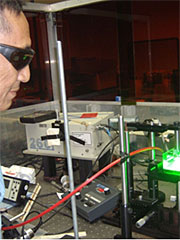- Number 337 |
- May 16, 2011
Non-toxic nanoparticles may someday be used to fight cancer

Dr. Phuoc Tran’s laser ablation
process is used to produce
nanoparticles of gold that can
be used in treating cancer and
as targeted drug delivery
vehicles.
Dr. Phuoc X. Tran’s research at DOE’s National Energy Technology Laboratory (NETL) has involved laser ignition, fluid dynamics, and heat transfer, all focused on fossil fuel combustion, until relatively recently, when his interest in laser nanoparticle ablation led him into conducting research on fighting cancer. Dr. Tran has developed a method of producing novel, non-toxic gold nanoparticles for cancer treatment to replace the potentially toxic nanoparticles typically produced by current chemical methods. The process involves only water, two lasers, and gold, and uses no toxic chemicals.
When green and infrared lasers strike the surface of a thin gold foil, gold nanoparticles are gouged from the surface in a process called laser ablation. The nanoparticles bunch together in water due to the surface forces, just as nanoparticles produced by standard chemical methods do. The individual nanoparticles must be “unbunched” to be injected into the human body. Standard practice has been to use a toxic surfactant to separate the particles, but Dr. Tran’s method uses corn starch, potato starch, or chitosan, a natural product from shellfish.
Dr. Tran is also investigating how natural products could possibly help him control the size and shape of the nanoparticles. The gold particles initially produced by laser ablation are usually spherical, but tiny cylindrical shaped particles, called nanorods, would be preferable. Typically, during clinical treatment, gold nanoparticles are injected into a tumor and then irradiated with infrared light, which can penetrate layers of the patient’s skin. The light heats up the gold and causes it to destroy nearby cancerous cells, but only if the nanoparticles are of the right size and shape to absorb the light. Gold nanorods with precisely the right length and diameter interact with infrared light, causing surface electrons to vibrate and heat up to destroy the cancer cells. Research continues to control laser parameters, the concentration of the natural substances, and the temperature and the mixing duration to control the shape and size of the gold nanoparticles.
Meanwhile, Dr. Tran’s collaborator at the University of Pittsburgh, Dr. Ann Robertson, is trying to attach pharmaceutically active cells to the gold nanoparticles so that they can be used to deliver different drugs where they are needed most. If the gold nanoparticles were toxic, they might destroy any attached cells, interfere with the attached drugs, or cause new problems in the patient because of the presence of even trace amounts of the toxic compounds. Dr. Tran’s non-toxic nanoparticles will avoid these problems—a major advance in this field.
Submitted by DOE's National Energy Technology Laboratory
